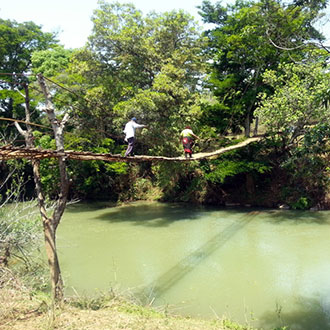
An MCHIP Officer and a Ministry of Health and Child Care (MOHCC) Environmental Health Officer cross the river from Makabvepi Village to Nyamatorenje Village.
For those living in Marimbita, Makabvepi, and Nyamatorenje villages in the Honde Valley in Manicaland Province’s Mutasa District in Zimbabwe, the craggy terrain can keep healthy people fit but can be a death sentence for the sick. Surrounded by many hills, valleys, networks of streams and rivers, and banana plantations, it is difficult for villagers experiencing the symptoms of malaria to seek treatment early and reach a health facility for care. The shortest route to reach Zindi Clinic, six kilometers away, is by crossing rickety, dangerous bridges, but avoiding the rivers means taking a longer route through the hills. As a result, too many of the community’s young children have died due to lack of access to health care. Those who do manage to reach the clinic often arrive in serious condition. This community was hit especially hard by malaria during the 2013–2014 malaria season, when nearly all the severe malaria cases reported at Zindi Clinic were from this hard-to-reach area.
In order to improve access to health care, in 2014, the President’s Malaria Initiative (PMI) supported the training of village health workers (VHWs) from Mutasa District in malaria community case management. A total of 170 VHWs were trained, most of whom were from these hard-to-reach communities. In addition to equipping the VHWs with knowledge and skills to identify and manage malaria, the training also empowered them to identify and assess children with danger signs and refer them early to the health facility. These trained VHWs were like a “dream come true” for the people of Marimbita, Makabvepi, and Nyamatorenje villages. As one mother, who was receiving care for her sick child, described, “We are happy that the VHWs are now testing and treating malaria in the community. We no longer delay to get assistance when our children get sick even during the night. We thank God and the clinic staff that have made this possible because reaching the clinic was a real challenge especially for us who have to cross the rivers and pass the mountains.”
Not only are the villagers grateful for the VHWs’ work, but also facility-based staff are appreciative as well. During supportive supervision visits, MOHCC staff witnessed the joy on the mothers’ faces as they received care from the VHWs. The commitment and skills displayed by the VHWs changed the perceptions of some health workers who had been reluctant to support the VHWs with resources. As a primary care nurse from one clinic recounted, after seeing the VHWs ably attend to patients and safely store medicines in a lockable box: “Now I am convinced that these VHWs are competent and know what they are doing. I am one of those people who had been hesitant to fully support them, but I can see that I have been doing a disservice to the community. These people need all the support we can give.”
